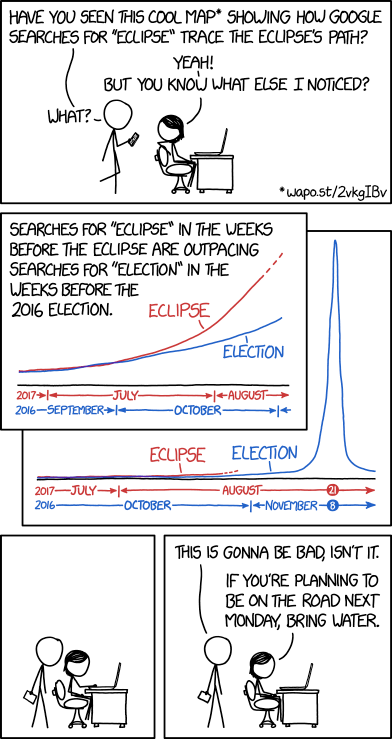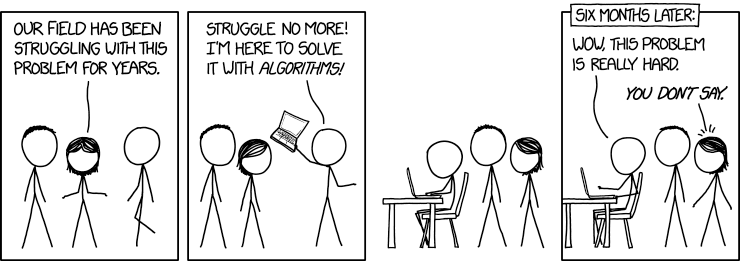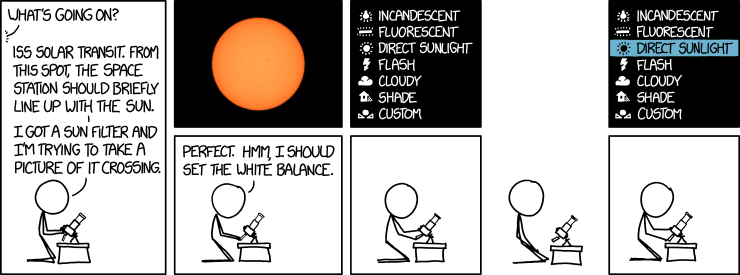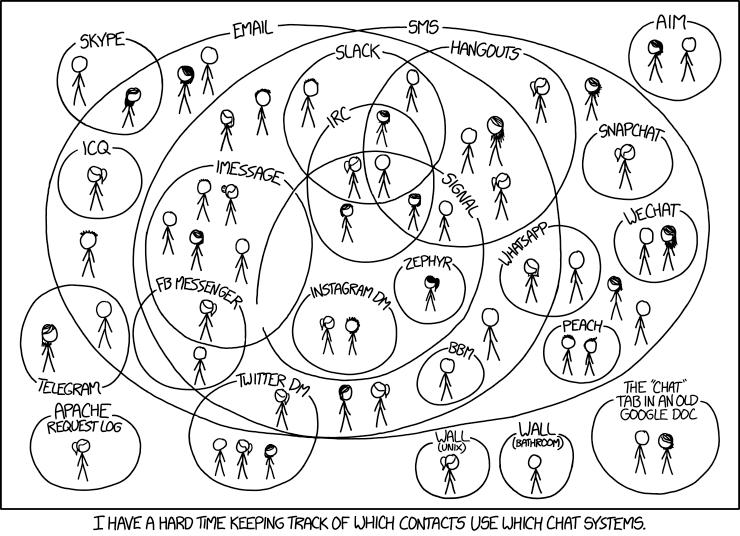
Shared posts
The Phenomenon Of “Crown Shyness” Where Trees Avoid Touching

Photo © Dag Peak. San Martin, Buenos Aires.
Crown shyness is a naturally occurring phenomenon in some tree species where the upper most branches in a forest canopy avoid touching one another. The visual effect is striking as it creates clearly defined borders akin to cracks or rivers in the sky when viewed from below. Although the phenomenon was first observed in the 1920s, scientists have yet to reach a consensus on what causes it. According to Wikipedia it might simply be caused by the trees rubbing against one another, although signs also point to more active causes such as a preventative measure against shading (optimizing light exposure for photosynthesis) or even as a deterrent for the spread of harmful insects. (via Kottke, Robert Macfarlane)






Alcohol as a study tool? Drinking after learning boosts memory

Enlarge (credit: Getty | FRANCOIS GUILLOT )
Cheers!—not to your health, but to your memory.
Drinking alcohol after learning information appears to aid the brain’s ability to store and remember that information later, according to a study of at-home boozing in Scientific Reports. The memory-boosting effect—which has been seen in earlier lab-based studies—linked up with how much a person drank: the more alcohol, the better the memory the next day.
The study authors, led by psychopharmacologist Celia Morgan of University of Exeter, aren’t sure why alcohol improves memory in this way, though. They went into the experiment hypothesizing that alcohol blocks the brain’s ability to lay down new memories, thus freeing up noggin power to carefully encode and store the fresh batch of memories that just came in. In other words, after you start drinking, your ability to remember new things gets wobbly, but your memory of events and information leading up to that drink might be sturdier than normal.
Specific area of the brain helps keep the body young

Enlarge (credit: Daniele Meli)
Age may not be a state of mind, but the brain is definitely involved. That's the conclusion of a study published on Wednesday in the journal Nature, which provides compelling evidence that a specific structure in the brain, called the hypothalamus, plays a significant role in controlling the entire body's aging. The results suggest stem cells play a critical role, but only in part via their ability to generate new neurons.
The results come from researchers at the Bronx's Albert Einstein College of Medicine. They, along with several other labs, have generated evidence that suggests the hypothalamus plays a key role in aging. That makes a certain amount of sense: aging is a systemic process, and the hypothalamus contains structures like the pituitary that release hormones that influence the entire body. And there have already been some indications that factors that control the dynamics of aging end up circulating through the blood.
Aging and stem cells
But what controls the timing of aging? One intriguing possibility is that neural stem cells are involved. These stem cells continue to divide and produce new neurons even after the brain is fully developed, but their numbers appear to go down over time (possibly because more of them produce new neurons than are replaced by cell divisions). If the key factors are produced by neural stem cells, then their levels should go down over time, allowing aging to proceed.
Study: Lumosity boosts brain function as much as normal video games—by 0%

Brain training may do little more than train healthy brains to be good at brain training, yet another study suggests.
In the new controlled, randomized trial involving 128 healthy young adults, researchers found that playing Lumosity brain-training games for 30-minute sessions, five times a week for 10 weeks resulted in participants getting better at playing the games. But researchers saw no changes in participants’ neural activity and no improvements in their cognitive performance beyond those seen in controls. The same went for participants who played video games not designed with cognitive benefits in mind.
The research, led by University of Pennsylvania psychologist Joseph Kable, is the latest ding to the billion-dollar industry that suggests its games can beef up mental abilities and ward off the cognitive declines of old age—among other things. Last year, Lumosity paid $2 million to the Federal Trade Commission to settle allegations that it baited customers with bogus claims that its games could cure and prevent mental declines and diseases, such as Alzheimer’s. No data suggest that the games can do that. And studies and analyses into the less grand claims of mental improvements have also been mixed: many found that benefits may only be seen in some users; those benefits may not extend beyond placebo effects, and they may not translate into real-world improvements in brain function.
When flatworms go to space, they grow two heads
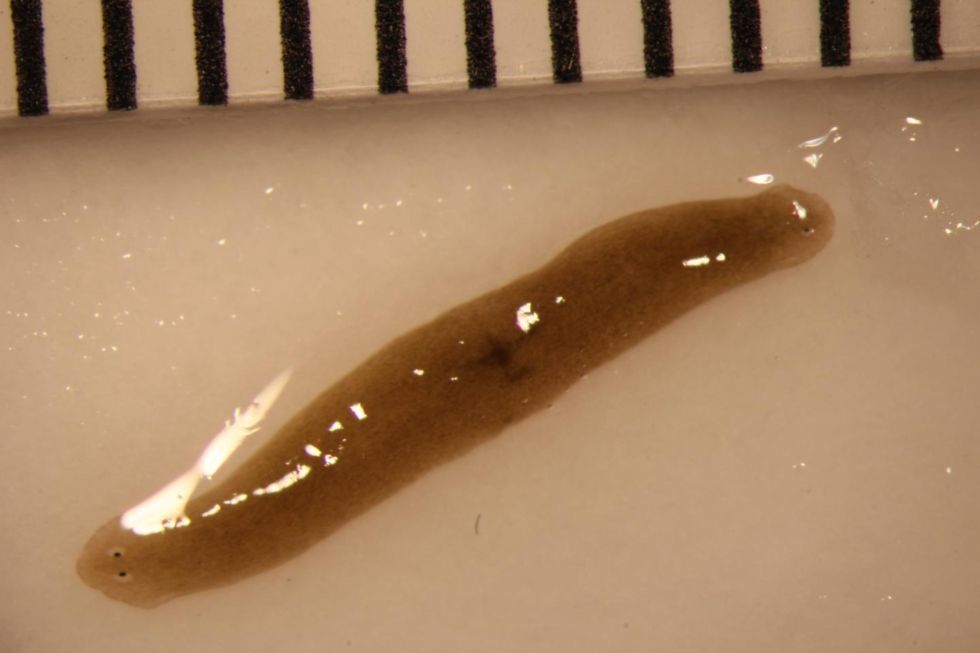
Among the hundreds of scientific tests happening on the International Space Station, only one has yielded a result worthy of a B-movie starring Ice Cube. It turns out that flatworms undergo an odd and as-yet-unexplained transformation in space. When profoundly injured, they grow a second head.
Scientists who study tissue regeneration have long been fascinated by flatworms because of the worms' ability to regrow after being cut in half. The worms can even regrow heads. But as Tufts University biology researcher Junji Morokuma and his colleagues explain in a paper for the journal Regeneration, they have never seen a worm grow two heads after amputation. But that's just what happened when an amputated flatworm was sent to the ISS back in January 2015.
Таймстрайп
https://timestripe.com

Эпической силы проект.
Подробности и процесс: https://www.artlebedev.ru/timestripe/
Genetically enhanced bacteria wired with color vision create artwork
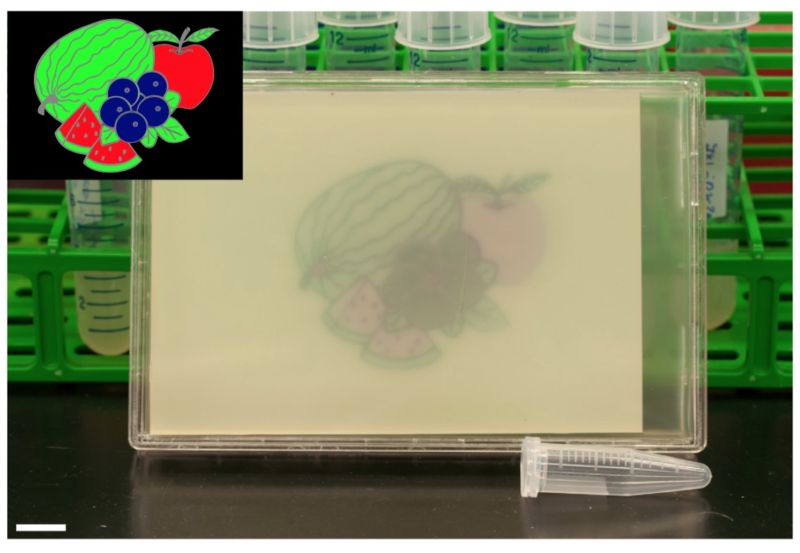
Enlarge (credit: Fernandez-Rodriguez et al.)
With genetically engineered color vision, gut-dwelling bacteria transform into vibrant artists—though their work is a bit derivative.
In a study published in Nature Chemical Biology, MIT researchers wired Escherichia coli with a synthetic network of 18 genes that allows them to sense and respond to red, green, and blue. Once excited by the colors, the genetic circuitry activates and inspires the bacteria to produce corresponding pigments or fluorescent proteins. Mats of microbes then turn their petri dishes into canvases, creating vivid replicas of patterns and artwork.
Right now, the bright bacteria simply demonstrate how far synthetic biologists have come in genetic tinkering. But, in the future, the researchers, led by MIT’s Christopher Voigt, hope that the RGB microbes could find a variety of applications. “Colored light offers many channels to pattern cells to build tissues or materials, control cells at a distance, or serve as a means of communication between electronic and biological systems,” Voigt and his colleagues write.
Japan, China have extracted methane hydrate from the seafloor

Enlarge / A photo from the China Geological Survey. The researchers extracted methane hydrate from the bottom of the South China Sea. (credit: China Geological Survey)
This month, teams from Japan and China have successfully extracted methane hydrate, a hydrocarbon gas trapped in a structure of water molecules, off the seafloor. The substance looks like ice but can be set on fire, and it’s energy-dense—one cubic meter of methane hydrate can contain 160 cubic meters of gas.
This makes searching for methane hydrate an attractive research project for several countries. According to the Department of Energy, methane hydrates are abundant on the seafloor and under permafrost, and they contain “perhaps more organic carbon that all the world’s oil, gas, and coal combined.”
Such vast reserves of fossil fuels are untapped because of how difficult it is to extract them. As a 2012 post from the Energy Information Agency (EIA) stated, until recently, methane hydrates “provided more problems than solutions.” Preventing their formation around deepwater oil and gas drilling operations has been a crucial part of planning ocean wells. The “ice” substance that contains the gas generally can’t just be picked up off the seafloor because it disintegrates outside of its high-pressure environment. The South China Morning Post wrote that current extraction efforts involve machinery “to depressurize or melt [the methane hydrate] on the sea bed and channel the gas to the surface.”
You're not going to believe what I'm about to tell you
South Indian frog oozes molecule that inexplicably decimates flu viruses

Enlarge / Hydrophylax bahuvistara (credit: Sanil-George-Jessica-Shartouny)
From the slimy backs of a South Indian frog comes a new way to blast influenza viruses.
A compound in the frog’s mucus—long known to have germ-killing properties—can latch onto flu virus particles and cause them to burst apart, researchers report in Immunity. The peptide is a potent and precise killer, able to demolish a whole class of flu viruses while leaving other viruses and cells unharmed. But scientists don’t know exactly how it pulls off the viral eviscerations. No other antiviral peptide of its ilk seems to work the same way.
The study authors, led by researchers at Emory University, note that the peptide appears uniquely nontoxic—something that can’t be said of many other frog-based compounds. Thus, the peptide on its own holds promise of being a potential therapy someday. But simply figuring out how it works could move researchers closer to a vaccine or therapy that could take out all flus, ditching the need for yearly vaccinations for each season’s flavor of flu.
Dark matter is missing from young galaxies

Enlarge / The European Southern Observatory's Very Large Telescope, based in Chile. (credit: ESO)
One of the earliest indications of the existence of dark matter came from an examination of the rotation of nearby galaxies. The study showed that stars orbit the galaxy at speeds that indicate there's more mass there than the visible matter would indicate. Now, researchers have taken this analysis back in time, to a period when the Universe was only a couple billion years old, and the ancestors of today's large galaxies were forming stars at a rapid clip.
Oddly, the researchers find no need for dark matter to explain the rotation of these early galaxies. While there are a number of plausible explanations for dark matter's absence at this early stage of galaxy formation, it does suggest our models of the early Universe could use some refining.
The measurements at issue here are what are called the "galaxy rotation curves." These curves track the speed at which stars rotate as a function of their distance from the center of the galaxy. If regular matter were all that was present, it would be easy to predict what we'd see. Close to the galaxy's center, stars would only feel a portion of the total galactic mass, so they would orbit at a relatively sedate speed. Any faster, and their orbits would shift outward.
40 years of data show immigration decreases or stabilizes crime rates

Enlarge (credit: Alex M. Hayward)
According to the White House Office of the Press Secretary, a recent Executive Order on Border Security and Immigration Enforcement was intended to address the issue of “significant increase in violent crime” due to immigration driven by “transnational criminal organizations.” These claims directly contradict the results of academic work on immigration and crime, and a recent study published in the Journal of Ethnicity in Criminal Justice reinforces that. It shows that immigration is not linked to increases in crime—in fact, this study suggests it's linked to reductions in certain types of crimes.
This study builds on previous findings on arrests and criminal offenses. That previous data showed that foreign-born residents of the US were less likely to commit crimes than native-born Americans. The new study looked at 200 major metropolitan areas as defined by the US Census Bureau. The researchers then used Census data and FBI crime reporting data from 1970-2010 to look at trends for these regions.
The authors were interested in increases in crimes that might be attributable to an influx of immigrants who decreased economic opportunities or ended up in jobs that might otherwise have gone to local-born residents. To that end, they looked at violent crimes and property crimes, including rates of murder, non-negligent manslaughter, aggravated assault, robbery, burglary, and larceny.
A Danish astronaut has captured the best-ever images of rare blue flashes

ESA/NASA
Scientists don't know much about the mysterious, powerful electric discharges that sometimes occur in the upper levels of the atmosphere in conjunction with thunderstorms. The first photograph of the phenomenon—which can occur as high as about 90km above the surface of the Earth and are known variously as sprites, pixies, elves, or jets—was only taken from Earth in 1989.
Fortunately for scientists interested in these storms, the International Space Station offers an excellent vantage point at an altitude of about 400km. So Danish researchers devised a "Thor experiment"—named after the hammer-wielding Norse god—to study the phenomenon. As part of the experiment, an astronaut on board the station would image thunderstorms under certain conditions, and these observations would be correlated with data collected by satellites and ground-based radar and lightning detection systems.
Shootings at school follow trends in the unemployment rate

Enlarge (credit: Thomas Hawk)
Part of why we struggle to understand school shootings is because there isn’t enough data available about these extremely rare events. A recent study published in Nature Human Behavior describes a carefully curated dataset for US school shootings between 1990-2013, created from existing data and original data sources.
In their analysis, the authors of this paper found that the rate of school shootings increased from 2007-2013. They also found data that suggested increased shooting rates were correlated with increases in unemployment rates. This finding indicates that high levels of economic distress may lead to increases in school-related gun violence.
Previous research on school shootings has resulted in contradictory claims because there hasn’t been a single, coherent dataset. Instead, multiple datasets with different inclusion criteria have made the resulting findings difficult or impossible to compare since they analyze fundamentally different information. To solve this problem, the authors made a new collection of school shooting data, which resulted in the inclusion of almost 400 events. Their criteria for inclusion in this dataset are:
Milky Way is not only being pulled—it’s also “pushed” by a void
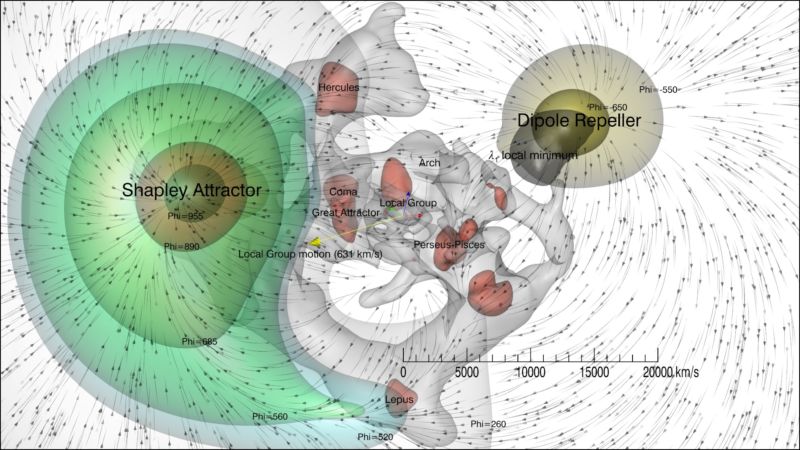
Enlarge / Labeled 3D model. The little arrows are galaxies, and the lines coming from them depicts their velocities (with the influence of the Universe's expansion on their velocities removed). Our galaxy, the Milky Way, is located in the Local Group, near the center of the image. The motions of all the galaxies seen here are dominated by the Shapley Attractor and the Dipole Repeller. (credit: Hebrew University of Jerusalem)
You may not notice it, but our Milky Way galaxy is cruising along at 630 kilometers (~391 miles) per second. That speed is often attributed to the influence of a single gravitational source. But in a new study, a group of researchers has found that the motions of the Local Group—the cluster of galaxies that includes the Milky Way—are being driven by two primary sources: the previously known and incredibly massive Shapley Supercluster and a newly discovered repeller, which the researchers dub the Dipole Repeller.
Shapley’s contribution was already known, but the Dipole Repeller’s hadn't been recognized prior to this study.
The researchers plotted the motions of many galaxies in the nearby Universe in a 3D model, using data from the Cosmicflows-2 database. Since the Universe is expanding, most galaxies are moving away from ours, creating a red-shift in the light they emit. But since the researchers were more interested in the other influences on a galaxy’s motion, they simply subtracted the expansion’s contribution. The resulting plot shows what the motions of galaxies would look like if space wasn’t expanding.
Matter-antimatter asymmetry confirmed in baryons
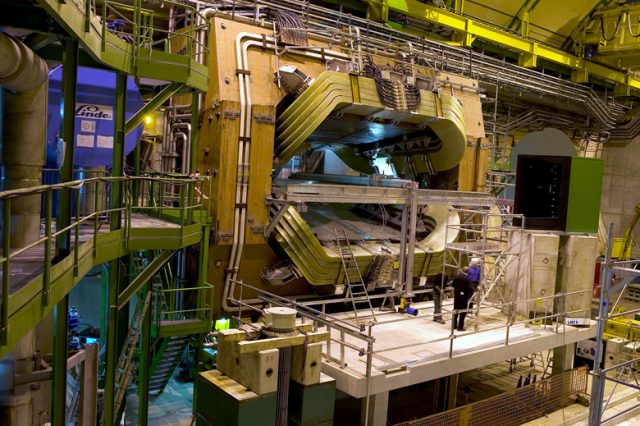
The LHCb detector. (credit: Fermilab)
Everyone, at some point in their lives, wonders why they are here. Existential questions don't stop at the personal level, though. Why is there a Universe, and why is it filled with matter? The last question is a puzzle that has gainfully occupied the minds of and employed physicists for many years. The time spent pondering such questions has not been wasted, as it turns out, as researchers from the LHCb detector report that one of the theoretical paths that allows matter to outnumber antimatter is open for business.
An overly simple reading of the Standard Model of physics predicts that matter will be produced at the same rate as antimatter. The antimatter and matter should, through simple statistics, collide and wipe each other out, leaving only energy. But that didn't happen. The substance we label matter was, somehow, produced in greater abundance than antimatter. In the beginnings of the Universe, antimatter was eliminated, leaving only matter.
A closer look at the Standard Model reveals that some imbalance is expected. But it also predicts a Universe with much less matter than we observe. And, experimentally, we've only observed the relevant matter/antimatter asymmetry for a particular class of particles, called mesons. That notably leaves out the particles that make up the Universe, called baryons. Luckily, baryon asymmetry is exactly what one of the LHC detectors, called LHCb, is designed to investigate.
Japan just tried to launch the world’s smallest orbital rocket

JAXA
This weekend Japan tried to launch a 3kg cubesat into orbit aboard its multi-stage, SS-520 rocket. Were it to have succeeded, the SS-520 would have become the smallest rocket to ever deliver a payload into orbit. Alas, the rocket did not make it.
According to the Japanese Exploration Agency, or JAXA, the sounding rocket launched on Sunday morning from the Uchinoura Space Center on the country's southernmost main island, Kyushu. Although the first stage fired normally, a preplanned check between first-stage separation and the second ignition did not show consistent telemetry data. This prevented the firing of the second stage, and the rocket fell into the Pacific Ocean, southeast of the spaceport.
In Fiji, ants have learned to grow plants to house their massive colonies
Though researchers have known for a while that ant colonies can live inside fruits, a new study in Nature Plants reveals that this housing arrangement is far more complex and ancient than we knew. University of Munich biologists Guillaume Chomicki and Susanne S. Renner went to Fiji to observe the ants and found that they inhabited six different species of Squamellaria. Each of these species evolved to grow in tree bark using a specialized root system called a foot. When the plants are still young, the ants enter a small cavity in the stalk called a domatium to fertilize it. Though the researchers never directly observed how the ants did the fertilizing, they speculate that basically the ants are pooping in there.
Global carbon emissions flatline continues

Enlarge (credit: Frank Friedrichs)
Even before the international Paris Agreement was completed last December, we had some encouraging news about greenhouse gas emissions. Despite an increase in global GDP, emissions were basically unchanged from 2014 to 2015. Previously, only recessions interrupted the relentless year-over-year rise of emissions. Now, an early projection for 2016 looks just about as good.
Keeping the books on global emissions and the rising concentration of atmospheric CO2 is an incredibly complex undertaking—it’s not as easy as checking your electric utility statement. The overall carbon budget for our atmosphere involves all the carbon exchanged with land ecosystems and the oceans, and there are lots of human emissions beyond energy. In the end, you can figure out how much human activities released and how much ended up in the atmosphere.
In a new paper, a huge team of researchers led by the University of East Anglia’s Corinne Le Quéré has published the latest update to the state of Earth’s carbon budget. This effort involves many sources of information, including tracking fossil fuel use for power, industry, and in homes, as well as items like the production of cement (which releases CO2 directly) and global trade. On top of that, there are data and models used to monitor the world’s ecosystems.

